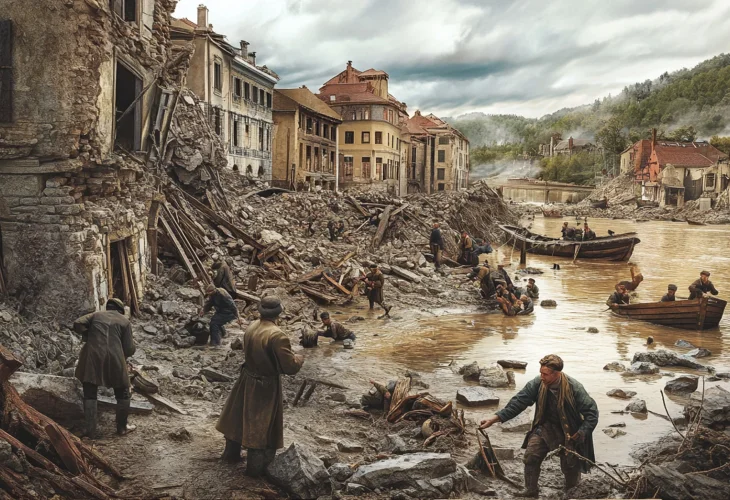The Great Tiberias Flood: A Devastating Tale of Tragedy and Resilience
The entire city of Tiberias was submerged under 3 meters of water. Fragile homes fell apart, some flattened by rocks tumbling from the mountains. People clung desperately to bars and posts; those who couldn’t were swept away.

Anyone who's visited Tiberias likely remembers the bustling promenade filled with tourists, attractions, and souvenir shops. It's always a pleasant visit, but historically speaking, the promenade's establishment is tied to a tragic chapter in the city's history.
Ninety years ago, the entire city of Tiberias was confined within its ancient walls, existing since the Turkish rule, when Dona Gracia rebuilt the city for the Jewish settlement. Where the promenade now stands, there was a natural slope leading down to the Sea of Galilee. The city's houses reached the slope’s edge, narrow alleys opened to the sea, and residents—some of whom made their living from fishing—would descend from their homes to their small boats, heading out to earn their livelihood.
On Monday, the 29th of Iyar, 5694 (May 14, 1934), at 11:30 AM, rain fell on Tiberias and the surrounding mountains for 45 minutes. Despite being summertime, this rain had the intensity of winter. The city's elders remarked, "Every drop is like a cup." Tiberias, surrounded by mountains, was inundated with massive water flows. These waters carried enormous basalt rocks, pelting the city. The rains funneled directly into Tiberias on their path to the Sea of Galilee. Water levels on the plain before Tiberias reached one and a half meters, but inside the city, the waters rose higher as buildings obstructed the flow, funneling waters into the alleys, which turned into raging rivers. The entire city was engulfed under 3 meters of water. The weaker homes crumbled and collapsed, some smashed by rocks tumbling from the mountains. People clung to bars or pillars with the last of their strength, while those who couldn’t hang on were carried away, battered by the debris in their path.
The old city was built on top of cellars, using space efficiently. Every house had a cellar. These were the first to flood, trapping people inside. The water pressure didn't allow doors and windows to be opened. Store windows shattered, and goods were swept into the Sea of Galilee. Within an hour, the floods stopped, raising the Sea of Galilee by about 15 centimeters immediately, but the city remained devastated, buried under thick mud, debris, and trapped inhabitants.
Two hundred homes in the city were destroyed, including the "Etz Chaim" synagogue. Many people rushed to clear debris and rescue the injured, but the renewed rains severely hampered their efforts. It took time to ascertain the disaster's true extent. Three days post-flood, an infant's body washed up near Allenby Bridge by Jericho. It had traveled from the Sea of Galilee to the Jordan River, drifting south. Days later, more bodies surfaced in the middle of the Sea of Galilee; searchers took boats to retrieve them for burial. In total, 32 people died, with a hundred injured.
Abraham Elmaleh, head of the Jewish Committee, noted the miracle that Tiberias’s children were at the time in a school on a hill west of the city, seeking shelter when the rain began. Had they been in the city, their lives would have been at great risk.
The British High Commissioner Wauqup arrived by plane, mobilizing 120 soldiers to help alongside 800 workers, scraping the mud from the city streets. This effort is documented in an authentic video, easily found. Many survivors were housed in structures near the grave of Rabbi Meir Baal Haness, as their homes were destroyed. In fact, most of the old city's homes were obliterated by the flood.
The Jewish community rallied to aid the survivors: Jews from Haifa sent 500 loaves of bread; Safed sent sacks of bread, olives, sardines, and other goods; and the Tel Aviv municipality sent 50 lira. The Sfarbro brothers sent 13,500 cigarettes. The "Agudat Yisrael" office in Jerusalem dispatched two truckloads of food and 60 lira to the organization members left with nothing on the eve of Shavuot; most of this funding, 50 lira, came as a donation from Warsaw Jews.
A special committee set assistance criteria for the survivors. Documentation lists that "it was approved to provide the widow Esther Mizrahi's four children with two glasses of milk a day for a month." That year, the social relief office noted about 50 Tiberias children lacked shoes, walking barefoot around the city.
Community members launched a fundraising campaign for Tiberias's rebuilding. It was agreed that "Hamei Tveria" would transfer a portion of the income collected from tourists to the rebuilding fund. Additionally, 5,000 free tickets for baths at Hamei Tveria were distributed to those whose health would benefit.
The British authorities undertook significant engineering works along the Sea of Galilee's shoreline. They excavated huge channels and pipes to drain rainwater streaming into the streets above the shore, pouring concrete along the entire shoreline. This is the promenade we walk along today. A few months later, another rainstorm struck the Tiberias hills, but this time the water flowed directly through vast channels into the Sea of Galilee, sparing Tiberias from harm.

